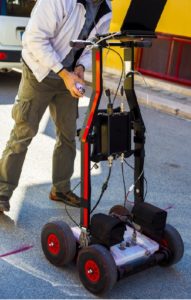
There are multiple underground utility locating methods available these days. Some are more effective than others. Some are better for certain sites. The two main forms of utility locating we’ll be looking at today are ground penetrating radar (GPR) and electromagnetic utility locating. We will compare ground penetrating radar with electromagnetic utility locating to help you to determine which is better to use on your construction site.
Electromagnetic Utility Locating
Electromagnetic utility locating is one of the most common means of detecting private utilities on construction sites. With this method, the equipment that’s used emits an electromagnetic radio frequency. When this frequency is used on the ground, workers can locate subsurface utilities that have conductive material in them.
This method of utility locating is used most often to detect things such as electric, telephone, water, gas, propane, sewer, irrigation, and cable lines. The biggest problem of using this method is that it isn’t able to find unmarked plastic, concrete, or asbestos. It also doesn’t do well when going beyond 15 feet underground. While the utility lines that electromagnetic utility locating finds are often found closer to surface level, it’s something you have to keep in the back of your mind.
Ground Penetrating Radar
Ground-penetrating radar, also known as GPR, is another utility locating method that is used for finding subsurface utilities with high-frequency waves. When using ground-penetrating radar, radio waves get sent into the ground. Subsurface utilities deflect the radio waves back to the surface. Then, the operator will be able to see the utilities that deflected the radio waves with the help of the technology this method uses.
People usually use ground-penetrating radar to find buried pipes and tanks, as well as cables, manholes, among other varieties of buried objects which can’t be found using different methods, including electromagnetic locating.
GPR requires extensive training and a wealth of experience to use properly. One of the main drawbacks is that the deeper an object is underground, the larger it has to be to get detected. It also has less effectiveness in areas with more dense soil. Highly conductive soils also make it harder for GPR to penetrate the soil.
Concrete Visions Will Get The Job Done Right
Concrete Visions has been working with clients for over 25 years. Our G&M Services installers are certified with the industry’s major firestop product manufacturers. As part of our firestop service, we can assess abnormal field conditions and, with the manufacturer’s technical support assistance, provide engineering judgments in a timely fashion to comply with contract specifications. Our Field Mechanics undergo ongoing training, including mandatory monthly safety meetings, weekly Toolbox Talks where safety and equipment information is shred, and trainings on safe work standards and safety best practices.
